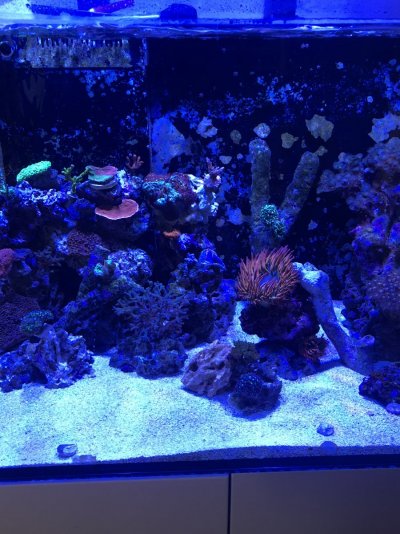My reef tank has been fallow (no fish) for 6 weeks (due to velvet outbreak).
I thought now would be a good time to set it up to get my nitrates down and add corals and try more SPS. After doing 2-3 20% water changes I noticed nitrates were not really budging. Salifert test kit was similar. I guessed nitrates were between 15 to 20 ppm based on color match.
I ordered a Hanna checker and to my surprise nitrates measured 8.9 ppm then a day or two later 10 ppm. I felt it was my test kit was off.
about 2 weeks later I decided to do about a 25% water change just for the hell of it. Remember I have no food input except maybe 1 cube a week for corals.
One day after Hanna checker read 18.5ppm.
I maybe have 10 hermit crabs, an emerald crab and Coral banded shrimp.
Only thing I can think of is I have had a lot of coralline algae die since I have been fallow and have had no skimmer running the entire time......but seriously I have done at least five 20-25% water changes in 6 weeks....so....
the tank was moved prior to all this which likely stressed my fish and LFS who moved my tank thoroughly cleaned the sand.....even though they were supposed to replace with all new.....
I also just switched to 6 stage RODI before this as well from running straight dechlorinated tap.
any other ideas on nitrate inputs? I always gravel vacuum every time I do a water change and I have vacuumed the sump. I am not running anything on the tank except filter socks and a bag of carbon at the moment.
I have had one SPS frag broke out at base and my light ate only set to 25% so not sure if. It’s nitrates. Calcium, alkalinity are good but alk in kinda high at 12.....I will attach pic of coral later today.
Thanks guys!
I thought now would be a good time to set it up to get my nitrates down and add corals and try more SPS. After doing 2-3 20% water changes I noticed nitrates were not really budging. Salifert test kit was similar. I guessed nitrates were between 15 to 20 ppm based on color match.
I ordered a Hanna checker and to my surprise nitrates measured 8.9 ppm then a day or two later 10 ppm. I felt it was my test kit was off.
about 2 weeks later I decided to do about a 25% water change just for the hell of it. Remember I have no food input except maybe 1 cube a week for corals.
One day after Hanna checker read 18.5ppm.
I maybe have 10 hermit crabs, an emerald crab and Coral banded shrimp.
Only thing I can think of is I have had a lot of coralline algae die since I have been fallow and have had no skimmer running the entire time......but seriously I have done at least five 20-25% water changes in 6 weeks....so....
the tank was moved prior to all this which likely stressed my fish and LFS who moved my tank thoroughly cleaned the sand.....even though they were supposed to replace with all new.....
I also just switched to 6 stage RODI before this as well from running straight dechlorinated tap.
any other ideas on nitrate inputs? I always gravel vacuum every time I do a water change and I have vacuumed the sump. I am not running anything on the tank except filter socks and a bag of carbon at the moment.
I have had one SPS frag broke out at base and my light ate only set to 25% so not sure if. It’s nitrates. Calcium, alkalinity are good but alk in kinda high at 12.....I will attach pic of coral later today.
Thanks guys!
















